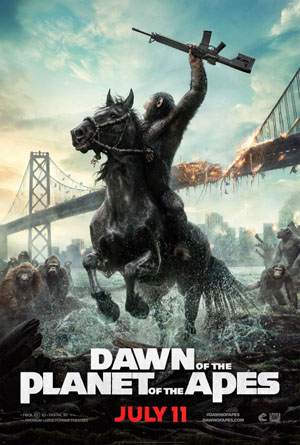 DAWN OF THE PLANET OF THE APES
DAWN OF THE PLANET OF THE APES(PG-13)
*** (out of 5)
July 11, 2014
STARRING
Andy Serkis as CAESAR
Jason Clarke as MALCOLM
Gary Oldman as DREYFUS
Keri Russell as ELLIE
Toby Kebbell as KOBA
Studio: 20th Century Fox
Directed by: Matt Reeves
BY KEVIN CARR
Listen to Kevin’s radio review…
I’ve always had a bipolar relationship with the “Planet of the Apes” series. On one hand, I respect the hell out of the original Charlton Heston film. However, having seen the movie many times over the years, I realize that it is imperfect. Add to this the fact that I read Pierre Boulle’s original novel in college, and I further realized that the 1968 version of the film failed to capture his vision.
Of course the 1968 film is a classic, and as recently as last summer, I sat down with my kids and watched all the installments of the series – including the bland Saturday morning cartoon and the sometimes interesting but still ineffective live-action television series. I still have a lot of love for the original film, and I respect the groundbreaking make-up work, but deep down I still feel there hasn’t been a proper adaptation of Boulle’s original book. (Don’t worry… I’m with many people in realizing that Tim Burton’s attempt in 2001 was a stumble, resulting in an ambitious but failed entry into the series.)
When “Rise of the Planet of the Apes” came out in 2011, I was thrilled. I found that movie to be fascinating, both from a story standpoint and a filmmaking perspective. I’ve always loved movies about people working in a lab to better humanity only to have their experiments go disastrously wrong, and this was the core conflict in this film. More over, it managed to bring a level of sympathy to the apes themselves that was not reached in the other films.
A lot of this was due to the astounding work from WETA Digital to create photorealistic apes from motion capture performances. It wasn’t just the brilliant work of Andy Serkis, but also the amazing effects work to make it look like real apes were inhabiting the movie. It was for this reason more than anything else that I was looking forward to “Dawn of the Planet of the Apes.” With three more years under its belt, I was excited to see what WETA could do with the apes again.
When it comes to “Dawn of the Planet of the Apes,” I am conflicted. From a visual effects standpoint, it is even better than “Rise of the Planet of the Apes.” More, diverse apes are shown in increasingly complex situations. The fact that you can follow the ape scenes and still know who was who is a testament to the detail that WETA puts into its product. Again, no real apes are anywhere near this movie, which makes these two movies as groundbreaking from an effects standpoint as “Avatar” and the “Star Wars” prequels were to achieving photorealistic environments.
However, from a story standpoint, I have to say I was a bit disappointed by “Dawn of the Planet of the Apes.” Perhaps it was because it was such a huge let-down from the previous film that carried such subgenre love from me. Perhaps it was because I liked the actors in the other film better. Perhaps it was because “Rise of the Planet of the Apes” deals with much of the same story elements as “Conquest of the Planet of the Apes” (my favorite of the original “Apes” films) while “Dawn of the Planet of the Apes” borrows heavily from “Battle for the Planet of the Apes” (the weakest installment, which was also the film that effectively killed the franchise for thirty years).
The story of this film is more simple. It’s been ten years since the virus, which gave the apes their intelligence and simultaneously devastated the human population with illness, was released. The human race has been reduced to tiny numbers, huddled together in cities. The apes, however, are flourishing in the woods outside of what used to be San Francisco. However, the apes and the humans clash when the men cross paths with them, hoping to restart a nearby dam for electricity.
The apes and the humans don’t trust each other. A small group of humans try to work with them to have a peaceful co-existence, but the leaders in the human city are intent on hoarding weaponry in fear of the eventual ape attack, which seems inevitable especially when the apes discover the stockpile.
“Dawn of the Planet of the Apes” is certainly better than “Battle for the Planet of the Apes,” but it’s not as deep or as complex as “Rise of the Planet of the Apes.” The messages and societal parallels are a bit heavy-handed at times, such as certain humans hating on the apes for supposedly unleashing the virus on humanity (which is inaccurate because they are more culpable of being vectors for the disease rather than the humans that inadvertently created it).
I have no issue with the apes in this movie, or the ape characters. It’s the human characters that are two dimensional and cliche. Still, it’s a pretty strong movie in a weak summer marketplace. With digital effects that blur the lines of reality as much as this film does, I’m further excited to see what they do with the next sequel. After all, there’ll be no existing film to draw from this time, so I’m curious to see where the overall story goes.
Podcast: Play in new window | Download

This film was a masterpiece. I was in awe.